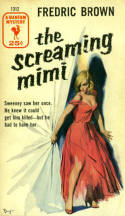 |
Bantam |
|
Click the group of books beginning with number:
|
Ian Ballantine, who started Bantam when he left Penguin in 1945, created some of the best paperbacks ever published. Ballantine didn't have enough money to start a publishing house himself, so he cobbled together a group of some of the greatest publishers in New York, promising to roll their various hardcover works into paperback reprint easily and affordably. The heads of these publishing houses, Bennett Cerf of Random House, John O’Connor of Grosset & Dunlap, Charles Scribner, Meredith Wood of the Book of the Month Club, and others, became Bantam's Board of Directors. Each of these men had a financial interest, therefore, in the rise of the American paperback reprint. The collaborative plan allowed them to take a cut of every sale made from reprints of their titles. As a result, they had absolutely no interest in Paperback Originals or other "innovations" seen in many other paperback houses. Ballantine was, above all else, a great believer in innovation. There was friction from the beginning; and in 1952, it came to a head. Ballantine was fired, and he left to finally form his own publishing house. After Ballantine departed, the company was without a president for almost a year and a half; and looking back, it couldn't possibly have been a worst period to lack firm guidance. There was a "glut" of paperback books due to overproduction; and there was uncertain literary direction due to censorship and other factors that had the entire industry in flux. Oscar Dystel took over in 1954, and he is credited with pulling the struggling publishing house back from the brink of extinction and setting it on the road to becoming one of the largest publishers in U.S. history. From the very beginning, Bantams were well bound, their cover art was sharp and vivid, and many of their titles endure as popular works today. Stopping short of illustrating the books themselves, Ballantine experimented for a brief time with pen & ink drawings on the inside covers. I've included these when possible, and labeled them "ic." They adorned many of the first hundred titles. The western, while pretty much a dead genre now, was immensely popular in the 40's and 50's. Bantam dedicated a fourth of their books to westerns. I've also included some dust jackets, extremely collectible today. Some of these were Infantry Journal and Superior Reprint books that Ballantine brought with him when he left Penguin and then wrapped them in Bantam dust jackets for re-release. There were numerous gaps in Bantam edition numbers. For example, there are no books between 262 & 300, and none between 557 & 700. Only Bantam NUMBERS determine the order of printing, with prefixes such as "A" and "F" in the early years (and seemingly most of the rest of the alphabet later on) interspersed to identify various prices and genres. In the "Other Bantams" folders, you will find the early Bantam Pathfinder series. The FB-series books were 50¢ biographies. "A-" and "AC" were special series books. NOTE: the later 4-digit Pathfinder, Matrix, Romance and other series books (after about 1965) are in their regular numbered sequence, interspersed throughout the other folders.
My Most Difficult Publisher Some publishers are easier for me to update on this website than others. Bantam is an absolute nightmare. For the most part, Bantams were printed in book number sequence, like other publishers. But Bantam put lettered prefixes on the majority of their later volumes. At first, they only indicated pricing, just like Gold Medal and Signet. In the 60's and 70's, they included literary genres, designated by a second letter, such as "B" for biography or "L" for romance. There are more than 60 lettered prefixes, and I have to go through them ALL when I update every individual web page, sorting by the numbers that follow those prefixes. Normally, I would consider a duplicated book number a "paperback oddity," but it happened so many times at Bantam that it was actually common. And so, you will see different titles and covers for Q4203 and QY4203. Also, S2643, Q2643 and F2643; A2284 and T2284. The list goes on and on. Collector Tom Daniels wrote me several emails in an attempt to make me understand this mishmash. (Tom runs the The Louis L'Amour Collector website, and as a result, he owns an awful lot of Bantam books.) First, based on Tom's explanations, I'll address the large number of duplicate numbers. In early 1975, Bantam ran out of numbers, so they started repeating numbers (beginning in the 2000's range) that year. By this period, a book's number was actually the middle part of the ISBN on the front cover, but it was usually printed as a stand-alone number on the spine. This system had been going on since 1969. Also, since the average cost of a paperback in 1975 was $1.25, many of these numbers contained a "Q" prefix, which designated that price. A year later, in 1976, Bantam went to a five-digit numbering system and the problem was solved. In many of these number duplications, it is VERY evident that one was printed substantially after the other. Where this occurs, I have assumed that the newer book was part of this 1975-specific problem, and I have redesignated the book as part of the five-digit series beginning with a preceding zero. So, for example, you will see scans in the "02000" folder such as "02140(Q2140)." The number in parenthesis is the actual number displayed on the book. Next, I will present:
Tom Daniel's list of primary Bantam prefixes:
(no letter prefix)
= 25¢ (unless it was a "Bantam Special Edition")
The Bantam database was updated in March, 2022
|